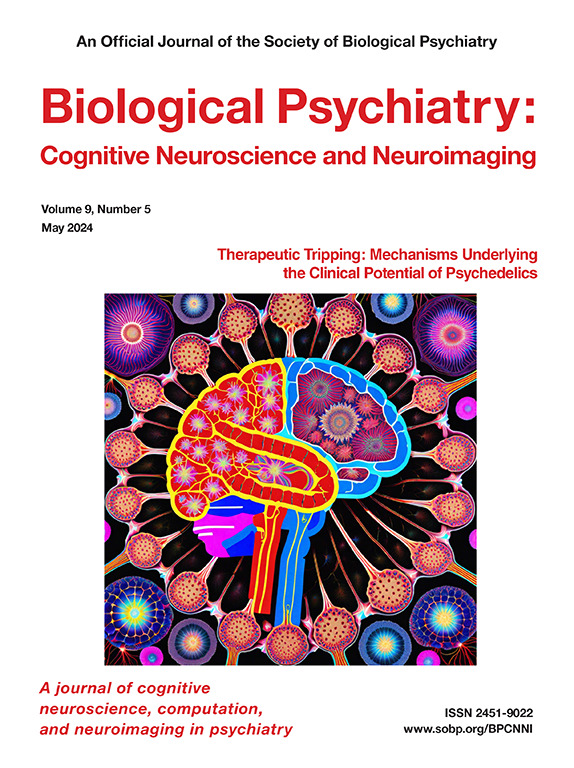Default Mode Network Functional Connectivity As a Transdiagnostic Biomarker of Cognitive Function
IF 4.8
2区 医学
Q1 NEUROSCIENCES
Biological Psychiatry-Cognitive Neuroscience and Neuroimaging
Pub Date : 2025-04-01
DOI:10.1016/j.bpsc.2024.12.016
引用次数: 0
Abstract
The default mode network (DMN) is intricately linked with processes such as self-referential thinking, episodic memory recall, goal-directed cognition, self-projection, and theory of mind. In recent years, there has been a surge in the number of studies examining its functional connectivity, particularly its relationship with frontoparietal networks involved in top-down attention, executive function, and cognitive control. The fluidity in switching between these internal and external modes of processing, which is highlighted by anticorrelated functional connectivity, has been proposed as an indicator of cognitive health. Due to the ease of estimation of functional connectivity–based measures through resting-state functional magnetic resonance imaging paradigms, there is now a wealth of large-scale datasets, paving the way for standardized connectivity benchmarks. In this review, we explore the promising role of DMN connectivity metrics as potential biomarkers of cognitive state across attention, internal mentation, mind wandering, and meditation states and investigate deviations in trait-level measures across aging and in clinical conditions such as Alzheimer’s disease, Parkinson’s disease, depression, attention-deficit/hyperactivity disorder, and others. We also tackle the issue of reliability of network estimation and functional connectivity and share recommendations for using functional connectivity measures as a biomarker of cognitive health.
默认模式网络功能连通性作为认知功能的跨诊断生物标志物。
默认模式网络(DMN)与自我参照思维、情景记忆回忆、目标导向认知、自我投射和心智理论等过程有着复杂的联系。近年来,对其功能连通性的研究激增,特别是其与涉及自上而下注意力、执行功能和认知控制的额顶叶网络(FPN)的关系。在这些内部和外部处理模式之间切换的流动性-由反相关功能连接突出-已被提出作为认知健康的指标。由于通过静息状态fMRI范式易于估计基于功能连接的测量,现在有大量的大规模数据集,为标准化连接基准铺平了道路。这篇综述深入探讨了DMN连接指标作为认知状态的潜在生物标志物的潜在作用,包括注意力、内部心理状态、走神和冥想状态,并调查了不同年龄和临床条件(如阿尔茨海默病、帕金森病、抑郁症、多动症等)中特征水平测量的偏差。此外,我们解决了网络估计和功能连接的可靠性问题,并分享了使用功能连接测量作为认知健康生物标志物的建议。
本文章由计算机程序翻译,如有差异,请以英文原文为准。
求助全文
约1分钟内获得全文
求助全文
来源期刊

Biological Psychiatry-Cognitive Neuroscience and Neuroimaging
Neuroscience-Biological Psychiatry
CiteScore
10.40
自引率
1.70%
发文量
247
审稿时长
30 days
期刊介绍:
Biological Psychiatry: Cognitive Neuroscience and Neuroimaging is an official journal of the Society for Biological Psychiatry, whose purpose is to promote excellence in scientific research and education in fields that investigate the nature, causes, mechanisms, and treatments of disorders of thought, emotion, or behavior. In accord with this mission, this peer-reviewed, rapid-publication, international journal focuses on studies using the tools and constructs of cognitive neuroscience, including the full range of non-invasive neuroimaging and human extra- and intracranial physiological recording methodologies. It publishes both basic and clinical studies, including those that incorporate genetic data, pharmacological challenges, and computational modeling approaches. The journal publishes novel results of original research which represent an important new lead or significant impact on the field. Reviews and commentaries that focus on topics of current research and interest are also encouraged.
 求助内容:
求助内容: 应助结果提醒方式:
应助结果提醒方式:


